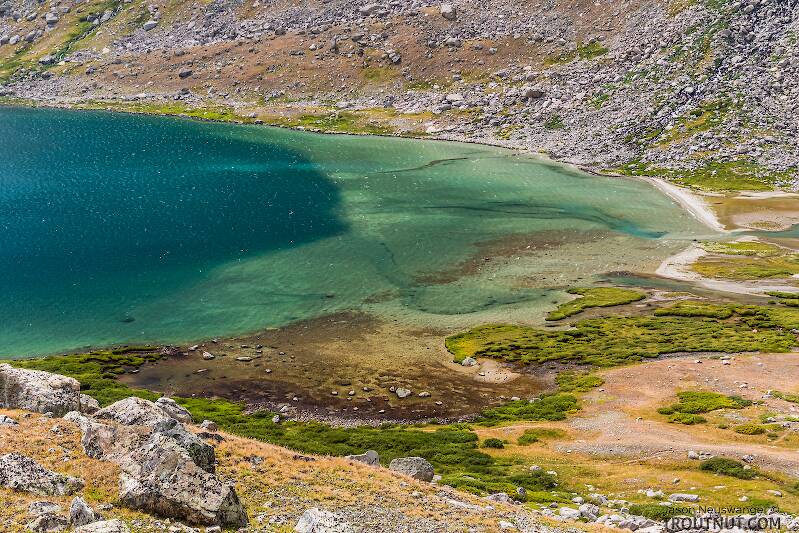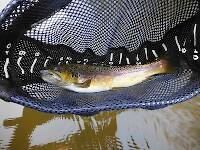
Salmonflies
Pteronarcys californica
The giant Salmonflies of the Western mountains are legendary for their proclivity to elicit consistent dry-fly action and ferocious strikes.
Featured on the forum

This species was fairly abundant in a February sample of the upper Yakima.

Troutnut is a project started in 2003 by salmonid ecologist Jason "Troutnut" Neuswanger to help anglers and
fly tyers unabashedly embrace the entomological side of the sport. Learn more about Troutnut or
support the project for an enhanced experience here.
Jodea on May 6, 2013May 6th, 2013, 9:55 am EDT
Fishing the daddie
Far from plenty during the early part of the season the Cranefly or more commonly known "daddielonglegs" is often disregarded when concidering the trouts diet
thought they do hatch in small numbers throughout the year fish generally ignore them until the later summer months when its emergance is at a peak
It is during these later summer and autumn months that the fly become ripe for the feeding fish and are picked of as they get blown onto the water.
the cranefly hatch out of the larve stage having been feeding on roots and vegetation mostely a few inches below the soil surface and thought trout do feed on theses larve when embankments are washed by rising water during floods but this is chance feeding and not selective feeding.
a completely different story once the larve has hatched into its fly form
Watch for the wind and water currents to guild you to a feeding fish and you will have great success fishing a live daddie
collect a dozen or so of various sizes using the "Jodea fly keep" ,this device makes it handy as the specially designed opening wont allow the fly the escape while accessing them,
you will find the cranefly a little more active than mayfly or wall fly and will most often get out of a box or jar when you open the lid so a jodea fly keep is essencial in this instance,
once gathered approach the bank with stealth watching for fish feeding close to the shore ,
using a small size 12 -14 hook and a long leader either dapp the fly using a longer rod or gently cast the fly with your standard fly rod ,
tip;i find if you tye a small piece of floss onthe hook behind the fly this will prevent the fly being ripped of the hook by the cast and can help to reach fish further away.
trout dont hesitate on the real fly like they do on its artificial counterpart they take the natural fly agressively and confindently enableing you more time to get the strike and hook the fish
late evenings can see larger trout hugging the shorline picking off the crane fly so it is worth to note that lifting and dropping the fly in a nautural manner can attract a specimine fish.keeping in mind any footfall or noise unnatural will spook the fish and your efforts may inturn be fruitless .
if you have tryed this method i would like to hear your opinions please or perhaps any other live fly for that matter. As an age old tradition in Ireland still practiced i would very much like to know if there is anywhere else in the world that might still fish this way ?
Far from plenty during the early part of the season the Cranefly or more commonly known "daddielonglegs" is often disregarded when concidering the trouts diet
thought they do hatch in small numbers throughout the year fish generally ignore them until the later summer months when its emergance is at a peak
It is during these later summer and autumn months that the fly become ripe for the feeding fish and are picked of as they get blown onto the water.
the cranefly hatch out of the larve stage having been feeding on roots and vegetation mostely a few inches below the soil surface and thought trout do feed on theses larve when embankments are washed by rising water during floods but this is chance feeding and not selective feeding.
a completely different story once the larve has hatched into its fly form
Watch for the wind and water currents to guild you to a feeding fish and you will have great success fishing a live daddie
collect a dozen or so of various sizes using the "Jodea fly keep" ,this device makes it handy as the specially designed opening wont allow the fly the escape while accessing them,
you will find the cranefly a little more active than mayfly or wall fly and will most often get out of a box or jar when you open the lid so a jodea fly keep is essencial in this instance,
once gathered approach the bank with stealth watching for fish feeding close to the shore ,
using a small size 12 -14 hook and a long leader either dapp the fly using a longer rod or gently cast the fly with your standard fly rod ,
tip;i find if you tye a small piece of floss onthe hook behind the fly this will prevent the fly being ripped of the hook by the cast and can help to reach fish further away.
trout dont hesitate on the real fly like they do on its artificial counterpart they take the natural fly agressively and confindently enableing you more time to get the strike and hook the fish
late evenings can see larger trout hugging the shorline picking off the crane fly so it is worth to note that lifting and dropping the fly in a nautural manner can attract a specimine fish.keeping in mind any footfall or noise unnatural will spook the fish and your efforts may inturn be fruitless .
if you have tryed this method i would like to hear your opinions please or perhaps any other live fly for that matter. As an age old tradition in Ireland still practiced i would very much like to know if there is anywhere else in the world that might still fish this way ?
Quick Reply
Related Discussions
Topic
Replies
Last Reply
3
Jun 17, 2017
by JohnR
by JohnR
3
Aug 31, 2013
by Jmd123
by Jmd123
0
Jan 27, 2017
by Mcflyangler
by Mcflyangler



